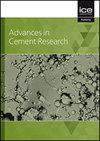Enhancing cement hydration by core/shell PS@SiO2 nanoparticles
IF 1.4
4区 工程技术
Q3 CONSTRUCTION & BUILDING TECHNOLOGY
引用次数: 0
Abstract
Nanoparticles are widely used in construction. Here, nano-SiO2 is employed, in a way that prevents agglomeration of the nanoparticles, as pozzolanic material to improve Portland cement hydration and to improve the properties of the concrete. To explore the effect of nano-SiO2 and core-shell PS@SiO2 on cement properties, spherical polystyrene particles were prepared by dispersion polymerization of styrene in polar solvents and characterized by FTIR and E-SEM. The core shells PS@SiO2 were synthesized by Stöber method. The results showed an amorphous nano-SiO2 layer can be deposited uniformly on polystyrene particles. This core/shell structure was reducing the aggregation of nano-SiO2 effectively. It was shown that PS@SiO2 particles improved the concrete performances compared to blended cement with nano-SiO2 due to the agglomeration affect. Highlights • Core/shell PS@SiO2 nanoparticles with a uniform coating layer were prepared. • As-prepared nanoparticles were characterized by a variety of advanced methods. • Nanoparticles accelerate hydration and lower the spatial weight of cement paste. • Core/shell nanoparticles improve cement hydration much better than nano-SiO2.通过核/壳 PS@SiO2 纳米粒子提高水泥水化效果
纳米颗粒被广泛应用于建筑领域。在这里,纳米二氧化硅以防止纳米颗粒团聚的方式被用作水合材料,以改善波特兰水泥的水化和混凝土的性能。为了探索纳米二氧化硅和核壳 PS@SiO2 对水泥性能的影响,我们通过苯乙烯在极性溶剂中的分散聚合制备了球形聚苯乙烯颗粒,并通过傅立叶变换红外光谱和电子扫描电子显微镜对其进行了表征。核壳 PS@SiO2 采用 Stöber 法合成。结果表明,无定形纳米二氧化硅层可以均匀地沉积在聚苯乙烯颗粒上。这种核/壳结构有效地减少了纳米二氧化硅的聚集。研究表明,与含有纳米二氧化硅的掺合水泥相比,PS@SiO2 颗粒可改善混凝土的性能。亮点 - 制备了具有均匀包覆层的核/壳 PS@SiO2 纳米粒子。- 采用多种先进方法对制备的纳米颗粒进行了表征。- 纳米颗粒可加速水化并降低水泥浆的空间重量。- 与纳米二氧化硅相比,核/壳纳米粒子能更好地改善水泥水化。
本文章由计算机程序翻译,如有差异,请以英文原文为准。
求助全文
约1分钟内获得全文
求助全文
来源期刊

Advances in Cement Research
工程技术-材料科学:综合
CiteScore
3.70
自引率
5.00%
发文量
56
审稿时长
3.2 months
期刊介绍:
Advances in Cement Research highlights the scientific ideas and innovations within the cutting-edge cement manufacture industry. It is a global journal with a scope encompassing cement manufacture and materials, properties and durability of cementitious materials and systems, hydration, interaction of cement with other materials, analysis and testing, special cements and applications.
 求助内容:
求助内容: 应助结果提醒方式:
应助结果提醒方式:


